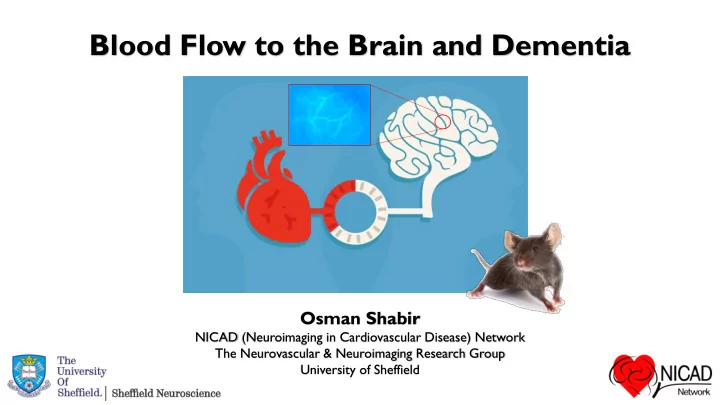

Blood Flow to the Brain and Dementia Osman Shabir NICAD (Neuroimaging in Cardiovascular Disease) Network The Neurovascular & Neuroimaging Research Group University of Sheffield
Blood Flow to the Brain • The brain accounts for just 2% of total body weight – yet receives 1/5 of total blood flow within the body every minute – why? • The brain (particularly neurons) are extremely energy-demanding and need lots of blood • Disturbances to blood flow to the brain ( reduced or blockages ) can cause stroke and/or dementia
Neurovascular Coupling Neuro – Neural (Brain Cell) Activity Vascular – Blood Vessels and/or Blood Flow Coupling – Relationship Between Neural Activity and Local Blood Flow Changes ↑ Oxygen and Glucose
PhD Aims and Methods ‘Healthy’ Mice Heart Disease Mice Atherosclerosis Healthy High-Fat Diet (Vascular Dementia) Controls Normal Diet Alzheimer’s + Heart Alzheimer’s with Alzheimer’s Mice Alzheimer’s Disease Mice Vascular Dementia Normal Diet Disease (Mixed Dementia) High-Fat Diet Aims • To investigate how blood flow to the brain is altered between ‘healthy’, heart -disease, Alzheimer’s and mixed dementia mice – through functional and structural methods Methods • Blood flow/volume imaging • Neural cell electrical activity • Tissue genetic and protein analysis Neural Electrical Activity Tissue Protein Analysis Blood Flow Imaging
Brain Blood ‘Flow’ Imaging • 2D-OIS – illuminating the surface of the brain with different colours (wavelengths) of light and recording the reflected light that corresponds to different blood composition ( Oxy , Deoxy & T otal ) Oxy-Hb T otal-Hb Deoxy-Hb Time
Alzheimer’s 10-15% GENETIC APP , PSEN1/2, APOE4, TREM2 85- 90% ‘SPORADIC’ Heart Disease, High Blood Pressure, Diabetes, Bad Diet, Low Exercise, Head Injuries Cerebral Amyloid Angiopathy (CAA) in 15m J20-AD Mouse
Blood Flow Responses in Dementia Healthy Control Pure Alzheimer’s Mixed Dementia (AD/ VaD) Oxy Oxy Oxy Hbt Hbt 2 2 Hbt 2 T otal T otal T otal Hbo Hbo Hbo Deoxy Deoxy Deoxy Hbr Hbr Hbr 1 1 1 0 0 0 0 16 0 16 0 16 Time(s) Time(s) Time(s) CHANGES TO BLOOD FLOW AND REGULATION IN DEMENTIA Overall Reduced Blood Flow to the Brain & Impaired Neurovascular Coupling
Risk Factors, Heart Disease & Dementia • Does cardiovascular disease affect neurovascular coupling in the brain? If it does, how and why? Vascular Factors Environmental Factors Genetic Risk Factors Lifestyle Factors e.g. High Blood Pressure, Diabetes, Atherosclerosis e.g. Air Pollution, Low Vitamin D e.g. APPSw, APOE4, PSEN1 etc. e.g. Diet, Exercise, Smoking etc. Brain Vessel Damage Heart Disease Breakdown, Fatty Deposits Build Up, Swelling, Leaking Stroke Neurovascular Breakdown Cerebral Blood Flow Reduction, BBB Breakdown, ↑ Toxic Accumulates Alzheimer’s Vascular Dementia
Cardiovascular disease causes a reduction in blood flow to the brain - Over the space of 12w/3m (=10-12 human years) – high-fat diet and lifestyle Oxy-Hb Oxy-Hb T otal-Hb T otal-Hb Deoxy-Hb Deoxy-Hb 10- 12 Years of ‘Western’ Diet and Lifestyle Build up Fatty Plaques inside Vessel Walls – Reduces Blood Flow Pre-Dementia (MCI) Potential
The Future • Neurovascular abnormalities are the first to present in people with Alzheimer’s HEALTHY HEART = HEALTHY BRAIN • Biomarkers for early alterations to blood flow to the brain (data from my PhD) • Targeting reduced blood flow (impaired neurovascular coupling) in the hope to VASCULAR keep the brain oxygenated to prevent dementias – future work in my lab Iturria-Medina et al, 2016 (Nature Communications)
BLOOD FLOW TO THE BRAIN AND DEMENTIA Thank You For Listening. Any Questions? Acknowledgments: Dr Jason Berwick Prof Sheila Francis Llywelyn Lee Dr Clare Howarth Dr Paul Sharp Dr Luke Boorman Also a special thanks to: WB BSU Staff (Beka Armstrong, Michelle Bird & Rachel Sandy) Dr. Julie Simpson & Monica Rebollar (SITraN) Dr. Devashish Das (Pre-Clinical MRI)
Recommend
More recommend